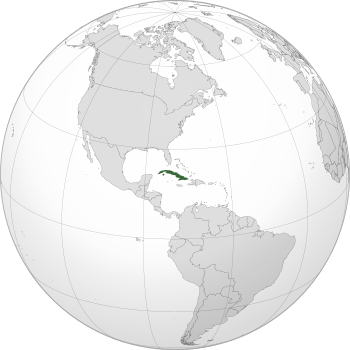United States Military Government in Cuba facts for kids
Quick facts for kids
United States Military Government in Cuba
Gobierno militar estadounidense en Cuba
|
|||||||||||
|---|---|---|---|---|---|---|---|---|---|---|---|
| 1898–1902 | |||||||||||
|
Motto: E Pluribus Unum
"Out of Many, One" |
|||||||||||
|
Anthem: Salve, Columbia
"Hail, Columbia" |
|||||||||||
 |
|||||||||||
| Status | Administered Territory of the United States | ||||||||||
| Capital | Havana | ||||||||||
| Common languages | Spanish, English | ||||||||||
| Government | Military Government | ||||||||||
| Military-Governor | |||||||||||
|
• 1898–1899
|
Adolfo Castellanos | ||||||||||
|
• 1899
|
John R. Brooke | ||||||||||
|
• 1899–1902
|
Leonard Wood | ||||||||||
| Historical era | Modern Era | ||||||||||
| 20 April 1898 | |||||||||||
| 10 December 1898 | |||||||||||
| 2 March 1901 | |||||||||||
|
• Independence
|
20 May 1902 | ||||||||||
|
|||||||||||
| Today part of | Cuba United States |
||||||||||
The United States Military Government in Cuba was a temporary government set up by the United States in Cuba. This happened after the Spanish–American War ended in 1898. During this time, Spain gave control of Cuba to the United States.
People also called this period the First Occupation of Cuba. This helps tell it apart from a second time the U.S. occupied Cuba from 1906 to 1909. Soldiers from the United States Army who served in Cuba during this first occupation later received the Army of Cuban Occupation Medal.
Contents
Key Events: US Rule in Cuba
This section looks at the important dates during the time the U.S. military governed Cuba.
1898: War and Treaty
- 15 February: The USS Maine ship exploded in Havana harbor. This event helped start the war.
- 20 April: U.S. President McKinley signed a resolution declaring war on Spain. This resolution included the Teller Amendment. This amendment said the U.S. would not take over Cuba permanently. It only wanted to bring peace.
- 10 December: Spain and the United States signed the Treaty of Paris. This treaty officially ended the war.
1899: Military Government Begins
- 1 January: The United States military government officially started in Cuba.
- 11 April: The Spanish–American War officially came to an end.
1901: New Constitution for Cuba
- 21 February: Cuba adopted its own new constitution, called the Constitution of the Republic of Cuba.
- 31 December: Estrada Palma was elected as the first president of the new Republic of Cuba.
1902: Cuba Becomes Independent
- 20 May: The new 1901 constitution became active. This day marked the birth of the independent Republic of Cuba.
The Platt Amendment: US Influence in Cuba
The Platt Amendment was a set of rules that decided when the United States would stop its military control of Cuba. This amendment was added to a U.S. army spending bill. Its goal was to give control of Cuba back to the Cuban people.
What the Platt Amendment Did
The amendment had eight main conditions that Cuba had to agree to. Only then would Cuba become fully independent.
- One key rule stopped Cuba from signing any treaties that would let other countries use the island for military bases.
- The United States also kept the right to step in if Cuba's independence was threatened. This was to protect lives and property, but the amendment did not clearly say how much the U.S. could interfere.
- Most importantly, the amendment made Cuba sign a treaty that made these rules official law.
Why the US Wanted the Platt Amendment
The United States wanted the Platt Amendment because it had many business interests in Cuba. Before the war, Spain had struggled to protect these U.S. interests and keep order. The amendment was a way for the U.S. to keep some influence in Cuba even after its military left.
The earlier Teller Amendment had promised Cuba its independence after Spanish rule ended. The Platt Amendment allowed the U.S. to maintain influence without directly ruling the country. It was successfully added to Cuba's constitution.
See also
 In Spanish: Primer gobierno militar estadounidense en Cuba para niños
In Spanish: Primer gobierno militar estadounidense en Cuba para niños



